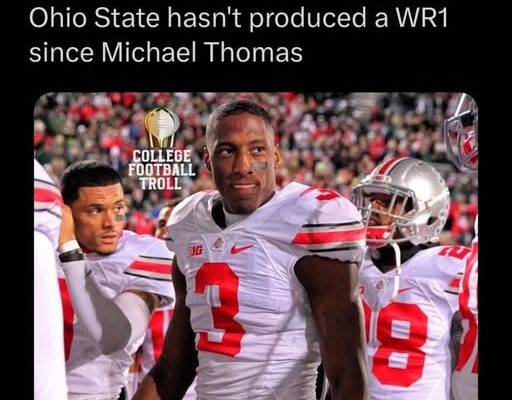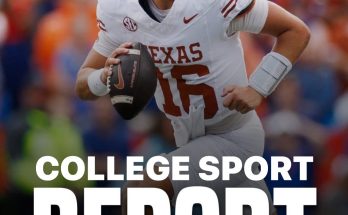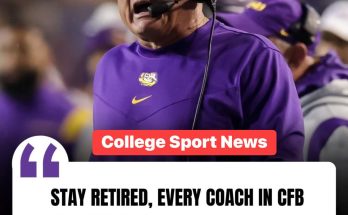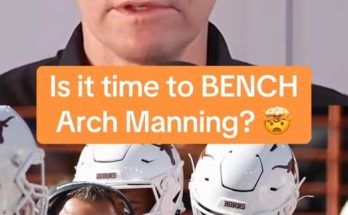College football has always thrived on tradition, reputation, and the ability of programs to stake their claim as the best at producing talent in certain areas. Some schools pride themselves on their dominance in the trenches, while others tout their quarterback lineage or defensive prowess. One of the more heated debates in modern college football, however, revolves around the title of “WRU” — Wide Receiver University. It is a nickname that signifies the program best at producing elite wide receivers, both in college and at the professional level. Recently, Ohio State has loudly embraced that claim, fueled by the success of a string of talented receivers who have emerged as stars in the NFL. From Garrett Wilson to Chris Olave, and from Terry McLaurin to Marvin Harrison Jr., Buckeyes fans argue that their school has clearly established itself as WRU. But when one digs deeper into the numbers, the history, and the broader context of college football, that assertion doesn’t hold up as strongly as Ohio State would like the world to believe.
The first thing to understand about the “WRU” debate is that it isn’t just about one or two great receivers coming through at the same time. If that were the case, then plenty of programs could argue for short bursts of dominance. LSU could point to the dynamic trio of Odell Beckham Jr., Jarvis Landry, and Justin Jefferson, followed by Ja’Marr Chase. Alabama could point to Julio Jones, Amari Cooper, Calvin Ridley, DeVonta Smith, Jerry Jeudy, Jaylen Waddle, and Jameson Williams. Miami could highlight Andre Johnson, Reggie Wayne, Santana Moss, and Michael Irvin. USC could remind the football world about legends like Lynn Swann, Keyshawn Johnson, and Mike Williams. The real weight of the WRU title lies in sustained excellence across decades, combined with impact at both the collegiate and professional levels. It is about proving that a program consistently recruits, develops, and produces the best talent at the position over generations, not just in a brief era. That is where Ohio State’s claim starts to lose strength.
Ohio State’s recent string of elite talent is undeniable. Garrett Wilson has already earned Offensive Rookie of the Year in the NFL, Chris Olave has quickly become one of the league’s most polished young route runners, and Terry McLaurin has established himself as a perennial 1,000-yard receiver despite inconsistent quarterback play in Washington. Marvin Harrison Jr., perhaps the most hyped receiver prospect in years, will soon enter the NFL with sky-high expectations. Jaxon Smith-Njigba, though slowed by injury, is another talent who could blossom in Seattle. If the discussion centered solely on the last five years, the Buckeyes might have a legitimate claim to the WRU crown. But football history is not so short-sighted, and when comparing Ohio State’s long-term receiver pedigree with other programs, the résumé is not nearly as dominant as some fans suggest.
Take Alabama, for instance. The Crimson Tide were long known for their running backs and defense, but over the last decade they have arguably transformed into the premier wide receiver factory. Not only have they produced volume, but also decorated receivers who have taken home individual awards and thrived in the NFL. Julio Jones set the modern standard and is viewed as one of the greatest receivers of his generation. Amari Cooper was a Biletnikoff Award winner and became a top-five NFL draft pick. Calvin Ridley carved out a strong early career. More recently, Alabama’s run from 2018 to 2021 produced back-to-back Heisman-level receivers, with DeVonta Smith winning the award outright in 2020. Jerry Jeudy and Jaylen Waddle were also first-round picks, as was Jameson Williams. Beyond first-round status, these players have translated quickly into professional success. Alabama’s case for WRU is built not just on hype but on consistent production, accolades, and long-term depth.
LSU also presents a strong challenge to Ohio State’s claim. Odell Beckham Jr. and Jarvis Landry revitalized the Tigers’ WR reputation in the early 2010s, both becoming Pro Bowlers and record-setters in the NFL. That alone would have been impressive, but LSU followed with Justin Jefferson, who has already established himself as arguably the best wide receiver in the NFL today, and Ja’Marr Chase, who has quickly joined him in the conversation. Those two not only dominated college football during LSU’s magical 2019 national championship run but also transitioned seamlessly into being top-tier NFL receivers almost immediately. It is rare for a program to boast two players who rank among the top five at their position in the entire NFL simultaneously, yet LSU can claim exactly that.
Miami, although its dominance at the position is more historical, cannot be overlooked in the WRU conversation. For decades, the Hurricanes were a wide receiver pipeline to the NFL. Michael Irvin was the face of the program’s swagger in the late 1980s before becoming a Hall of Fame legend with the Dallas Cowboys. Reggie Wayne, Andre Johnson, and Santana Moss all enjoyed long, productive careers in the NFL. Collectively, that core built a legacy that stretched well beyond just individual names — they helped define eras of both college and professional football. If WRU is about building an identity across decades, then Miami’s contribution cannot be dismissed simply because they haven’t produced stars at the same rate in the last 10 years.
USC offers another case study. In the Pete Carroll era alone, the Trojans fielded dominant college receivers like Mike Williams, Dwayne Jarrett, and Robert Woods. Later, Marqise Lee won the Biletnikoff Award, and JuJu Smith-Schuster became a Pro Bowl-level NFL player. Going back further, Lynn Swann and Keyshawn Johnson both became Super Bowl champions and Hall of Famers. That depth across eras illustrates that USC has a tradition stretching far beyond a single group of players.
When compared to these programs, Ohio State’s claim starts to seem less certain. Until recently, Ohio State was not viewed as a wide receiver powerhouse. The Buckeyes were more often recognized for their dominance at running back and defensive back. Great receivers like Cris Carter, Joey Galloway, and Terry Glenn certainly represented Ohio State in the NFL during the 1980s and 1990s, but the school was not consistently churning out multiple elite receivers in the way Miami, USC, or even Florida schools were at the time. In fact, there was a long stretch in the 2000s and early 2010s where Ohio State receivers rarely made a significant NFL impact. For every Santonio Holmes, who had a productive career and a Super Bowl MVP, there were multiple Buckeye receivers who fizzled out after being drafted.
The Buckeyes’ modern push for WRU branding is largely a product of recruiting success under Ryan Day and the brilliance of receivers coach Brian Hartline, who has built a reputation as one of the best recruiters and developers of wideout talent in the country. Hartline’s work has undeniably raised Ohio State’s profile, but it is important to recognize that this success is recent. One cannot erase decades of underwhelming receiver production in order to suddenly crown a program WRU after a single wave of stars. If Ohio State continues this trend for another decade, then their argument could strengthen significantly. But as of now, their résumé lacks the longevity and depth required for the title.
Another flaw in Ohio State’s claim is the overemphasis on draft status rather than NFL production. Yes, the Buckeyes have had multiple first-round wideouts in recent years, but high draft picks do not automatically equal WRU credentials. Plenty of first-round wideouts across the sport have gone on to disappoint in the NFL. The true measure of a program’s development comes in how many of those players translate their potential into long careers and accolades. Alabama and LSU, for instance, not only sent receivers to the NFL but also saw them become dominant forces. Jefferson and Chase are already among the NFL’s elite. Julio Jones was a perennial All-Pro. DeVonta Smith played a key role in a Super Bowl run. By contrast, it is still too early to judge how Ohio State’s recent class of receivers will stack up in the long term. Garrett Wilson and Chris Olave look promising, but they still have years to go before they can be mentioned in the same breath as Jefferson, Chase, or Julio.



